| Abbey Church of Our Lady of Montserrat | |
|---|---|
| |
 Abbey façade in 2014 | |
| 14°35′57″N 120°59′35″E / 14.599113°N 120.992946°E | |
| Location | 638 Mendiola Street, San Miguel, Manila, Metro Manila |
| Country | Philippines |
| Denomination | Roman Catholic |
| Religious order | Benedictines |
| History | |
| Status | Abbey |
| Founded | 1895 |
| Founder(s) | José Deas y Villar |
| Dedication | |
| Consecrated | January 13, 1926 |
| Architecture | |
| Functional status | Active (Abbey and University Church) |
| Architect(s) | George Asp |
| Style |
|
| Completed | January 13, 1926 |
| Specifications | |
| Number of towers | 2 |
| Number of spires | 17 |
| Administration | |
| Archdiocese | Manila |
| Clergy | |
| Abbot | Austin Cadiz |
| Prior | Angelo Legal |
The Abbey of Our Lady of Montserrat, or Manila Abbey, is a Benedictine men's monastery located on Mendiola Street in Manila, the Philippines. The monastery was founded by monks from Spain in 1895, in the final years of Spanish colonial era in the Philippines and is dedicated to Our Lady of Montserrat.
The resident monks, which belong to the Philippine Pro-Province of the Subiaco Cassinese Congregation (a part of the Benedictine Confederation) also operate San Beda University on the abbey's grounds.[1]
History
Origins
In the 19th century, several anti-clerical governments in Spain took measures to suppress the many monasteries there. If they were not closed outright, communities were forbidden by the state to accept new candidates, with the goal of letting monastic communities die out. With time however, exceptions were made for monasteries which would operate in the far-flung regions still a part of Spain's once mighty empire, primarily the Philippines.[2]
As a result of this incentive, the ancient Benedictine Abbey of Our Lady of Monserrat near Barcelona made the decision to establish a mission foundation in the area of Manila. The plan was for the community to follow the agrarian way of life which was part of the reform then under way by the recently formed Subiaco Congregation (forerunner of the present congregation) and provide pastoral care of the local population. On September 12, 1895, eight choir monks and six laybrothers, under the leadership of Dom José Deas y Villar arrived in Manila. After being hosted by the local Jesuit community, the monks obtained property for themselves in Surigao, which they occupied on April 25 of the following year.[2]
American period
The American occupation of the Philippines in 1898, in the course of the Spanish–American War, changed the new monastery's situation dramatically. Loss of financial support from the Spanish crown for the Catholic missions in the country left the community in desperate straits. Given that, and a desire on the part of the abbot of the community to counteract the new influence of Protestant missionaries, who had arrived under the protection of the American government, the monks decided to turn to education as their focus. On June 17, 1901, they opened San Beda College, named after the great English Benedictine scholar and saint, the Venerable Bede, on Arlegui Street. The curriculum consisted of elementary, secondary and initial university studies, with graduates awarded either a Bachelor of Arts degree or a diploma in business. The college was accredited and affiliated by and to the Pontifical University of Santo Tomas in 1906.[2]
By that time, the monastery grounds had become too small for the monks and the college, so the monks purchased land on Mendiola Street. In 1909, they entrusted the pastoral care of the region to Missionaries of the Sacred Heart from the Netherlands and moved to their current location, which they expanded in 1918. The cornerstone of the abbey church was laid on February 15, 1925, and it was completed and consecrated on January 13, 1926, to the Infant of Prague.
It was built in a Neogothic exterior, with a Neo-baroque interior painted by Dom Lesmes López, a Spaniard, and Brother Salvador Alberich.[1][3] The pair worked on the abbey church from 1931 to 1939, leaving only the back wall of the nave above the entrance blank. Dom Lesmes López's paintings on the vaulted ceiling of the nave include the 16 allegories on the virtues, theology and the church. "The Apotheosis of the Holy Name of Jesus" were painted over the sanctuary, while on its walls are eight panels on the Nativity of the Lord. Paintings of the Stations of the Cross are also seen within the interior of the church.[4]
Present condition
By 1971, the monastic community had gone from a high point of some 100 monks to a membership of thirty.[1]
In 2010, Aelred Nilo designed the final mural to fill the back wall of the nave, which was then executed by the Italian painter Francesco Giannini on 126 square metres of jute canvas. The mural depicts the history of the present congregation, as well as the resurrected Christ, saints, and various other religious figures, some based on real-life photographs.[5]
List of abbots
The abbey has been led by eight abbots throughout its history.[6]
- Raimundo Salinas (1925–1939)
- Pedro Celestino Gusi (1947–1957) — Elected Abbot President of the Subiaco Congregation
- Wilfrido Rojo (1958–1962)
- Bernardo Lopez (1962–1968)
- Eduardo Africa (1980–1986) — First Filipino abbot
- Andres Formilleza (1989–1998)
- Tarcisio Narciso (2001–2013)
- Austin Cadiz (2018–present)
Gallery
 Façade
Façade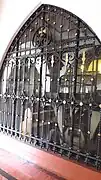 Details of the ground level windows
Details of the ground level windows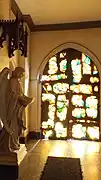 Stained glass door
Stained glass door Glass doors at the narthex
Glass doors at the narthex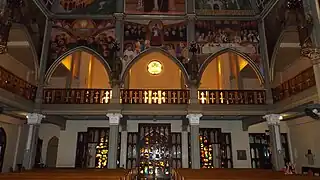 The Choir Loft and supporting gothic arches
The Choir Loft and supporting gothic arches Gospel nave
Gospel nave Paintings at the ceiling
Paintings at the ceiling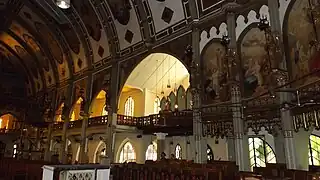 Design of the interior, right side
Design of the interior, right side Left transept
Left transept Organ in the right transept
Organ in the right transept Details of the posts
Details of the posts Altar at the transept chapel
Altar at the transept chapel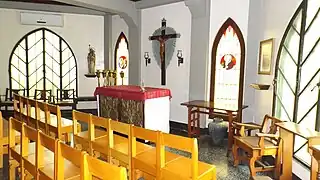 Chapel
Chapel Flooring of the chancel
Flooring of the chancel Details of the pulpit
Details of the pulpit Main freestanding altar
Main freestanding altar Choir stalls at the chancel
Choir stalls at the chancel Candle holder
Candle holder Statue of the Holy Infant of Prague enshrined in the cedar wood retablo
Statue of the Holy Infant of Prague enshrined in the cedar wood retablo Close-up of the Holy Infant of Prague
Close-up of the Holy Infant of Prague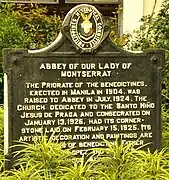 Historical Marker
Historical Marker Statue of Our Lady of Montserrat statue
Statue of Our Lady of Montserrat statue
See also
References
- 1 2 3 "In Search of Silence: The Cloister of San Beda Abbey (Mendiola, Philippines)". Hecho Ayer. April 1, 2012.
- 1 2 3 Santander, Noel. "Benedictine Presence in the Philippines". St. Benedict and the Holy Rule.
- ↑ "Abbey Of Our Lady Of Monserrat, San Beda, Manila". Philippine Churches.
- ↑ "Churches to visit in QC, Manila". Philippine Daily Inquirer. March 27, 2013. Retrieved 25 October 2014.
- ↑ Paska, Tracey (June 29, 2012). "New mural adorns the Abbey Church of Our Lady of Montserrat". Philippine Daily Inquirer.
- ↑ "San Beda Rt. Rev. Dom Austin P. Cadiz, OSB, eighth abbot". BusinessMirror. 26 March 2018. Retrieved 27 December 2020.
External links
 Media related to Abbey of Our Lady of Montserrat (Manila) at Wikimedia Commons
Media related to Abbey of Our Lady of Montserrat (Manila) at Wikimedia Commons
